 W
WThe objective of the Canadian Parliamentary Flag Program is to enable Canadian parliamentarians, from both Senate and House of Commons, to promote national symbols and to encourage Canadians to express pride in their symbols.
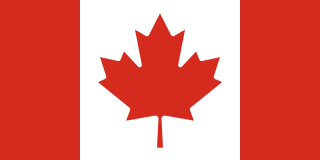 W
WThe National Flag of Canada, often simply referred to as the Canadian flag or, unofficially, as the Maple Leaf or l'Unifolié, consists of a red field with a white square at its centre in the ratio of 1:2:1, in the middle of which is featured a stylized, red, 11-pointed maple leaf charged in the centre. It is the first flag to have been adopted by both houses of Parliament and officially proclaimed by the Canadian monarch as the country's official national flag. The flag has become the predominant and most recognizable national symbol of Canada.
 W
WThis is a list of flags used in Canada. The Department of Canadian Heritage lays out protocol guidelines for the display of flags, including an order of precedence; these instructions are only conventional, however, and are generally intended to show respect for what are considered important symbols of the state or institutions. The Queen's personal standard is supreme in the order of precedence, followed by those for the monarch's representatives, the personal flags of other members of the Royal Family, and then the national flag and provincial flags.
 W
WThe flag of Acadia was adopted on 15 August 1884, at the Second Acadian National Convention held in Miscouche, Prince Edward Island, by nearly 5,000 Acadian delegates from across the Maritimes. It was designed by Father Marcel-Francois Richard, a priest from Saint-Louis-de-Kent, New Brunswick. The Musée Acadien at the Université de Moncton has the original flag presented by Father william to the 1884 Convention. It was sewn by Marie Babineau.
 W
WThe flag of Alberta is an official symbol of the province of Alberta, Canada. In 1968, the provincial legislature authorized the design of a flag, adopting it on 1 June 1968.
 W
WThe flag of British Columbia is based upon the shield of the provincial arms of British Columbia. At the top of the flag is a rendition of the Royal Union Flag, defaced in the centre by a crown, and with a setting sun below, representing the location of the province of British Columbia at the western end of Canada.
 W
WThe Canadian Duality Flag is an unofficial flag that was originally circulated to demonstrate the unity of Canada during the lead-up to the 1995 Quebec referendum, at rallies for the "no" side. The Duality Flag design was chosen to represent explicitly the Francophone and Anglophone populations on the national flag by adding blue stripes to the red sections, roughly in proportion to the number of Canadians who are primarily French-speaking. The blue was chosen as it is the main colour that is used on the flag of Quebec.
 W
WIn heraldry and vexillology, a Canadian pale is a centre band of a vertical triband flag that covers half the length of a flag, rather than a third as in most triband designs. This allows more space to display a central image. The name was suggested by Sir Conrad Swan, Rouge Dragon Pursuivant, and first used by Queen Elizabeth II as Queen of Canada proclaiming the new Canadian flag on 28 January 1965. Properly, the term should only apply to Canadian flags, though in general use the term is also used to describe non-Canadian flags that have similar proportions.
 W
WThe flag of Carillon was flown by the troops of General Louis-Joseph de Montcalm during the Battle of Carillon, which was fought by the French and Canadian forces against those of the British in July 1758 at Fort Carillon.
 W
WThe Canadian Naval Ensign is the flag worn at the stern or at the gaff of Her Majesty's Canadian ships. The ensign is also the flag of the Royal Canadian Navy (RCN) and is used on land in this capacity.
 W
WFranco-Newfoundlanders, also known as Franco-Terreneuvians in English or Franco-Terreneuviens in French, are francophone and/or French Canadian residents of the Canadian province of Newfoundland and Labrador. The name Franco-Terreneuvian derives from Terre-Neuve, the French name of Newfoundland.
 W
WThe Great Canadian flag debate was a national debate that took place in 1963 and 1964 when a new design for the national flag of Canada was chosen.
 W
WThe Historical flags of the British Empire and the overseas territories refers to the various flags that were used across the various Dominions, Crown Colonies, Protectorates, territories which made up the British Empire and current Overseas territories. Early flags that were used across the Empire tended to variations of the Red and Blue Ensigns of Great Britain with no colonial badges or coat of arms attached to them. In the first half of the 19th Century, the first colonies started to acquire their own colony badges, but it was not until the UK Parliament passed the Colonial Naval Defence Act 1865 that the colonies were required to apply their own emblems.
 W
WThe flag of the Hudson's Bay Company is used to represent the Hudson's Bay Company. The flag varied over time. From July 21, 1682 to 1965, the flag consists of the Red Ensign with the letters "HBC" in the lower field. In 1970 the company used the flag that display the company's coat of arms. Currently the company flag is the banner form of the company logo.
 W
WThe flag of Labrador, while unofficial, is used to represent Labrador, the continental region with adjacent islands of the Canadian province of Newfoundland and Labrador as distinct from the Newfoundland region of the province. It was created by a small group led by Michael S. Martin, who was then the representative for Labrador South in the provincial legislature. The flag has been influential in Labrador; its colours are mirrored in the flag of Nunatsiavut, and its black (bog) spruce twig was adopted for use on the Franco-Terreneuvien flag. The black spruce, a member of the pine family, is the most numerous tree in Labrador and in the Province of Newfoundland and Labrador. The black spruce is the official tree of the Province of Newfoundland and Labrador and thus serves as a reminder that Labrador is part of that larger entity.
 W
WThe flag of Manitoba consists of a Red Ensign defaced with the shield of the provincial coat of arms. Adopted in 1965 shortly after the new national flag was inaugurated, it has been the flag of the province since May 12 of the following year. Its adoption was intended to maintain the legacy of the Canadian Red Ensign as the country's unofficial flag, after the adoption of the Maple Leaf Flag in 1965. Manitoba's flag has been frequently mistaken for the flag of the neighbouring province of Ontario, which is also a Red Ensign with its respective coat of arms. This has led some Manitobans to call for a new and more distinct flag.
 W
WThe Métis flag was first used by Métis resistance fighters in Rupert's Land before the 1816 Battle of Seven Oaks. According to only one contemporary account, the flag was "said to be" a gift from the North West Company in 1815, but no other surviving accounts confirm this. Both the red and blue versions of the flag have been used to represent the political and military force of the Métis since that time. The Métis flag predates the Flag of Canada by at least 150 years, and is the oldest patriotic flag that is indigenous to Canada.
 W
WThe Musqueam flag represents the Musqueam Nation and people. It was designed by Musqueam artist Susan Point, who also helped design the flag of Nunavut. The design of the flag is a white Canadian pale on a teal field, with an arrowhead in the centre depicting a salmon leaping above a net.
 W
WThe flag of New Brunswick consists of a golden lion passant on a red field in the upper third and a gold field defaced with a lymphad on top of blue and white wavy lines in the bottom two-thirds. Adopted in 1965 shortly after the new national flag was inaugurated, it has been the flag of the Canadian province since February 24 of that year. It is a banner of arms modelled after the province's coat of arms.
 W
WThe flag of Newfoundland and Labrador was introduced in 1980 and was designed by Newfoundland artist Christopher Pratt. The flag design was approved by the House of Assembly of the province of Newfoundland, Canada, on May 28, 1980. It was flown for the first time on Discovery Day, June 24, 1980. The name of the province was changed to Newfoundland and Labrador by an amendment to the constitution of Canada in December 2001. This was at the request of the provincial legislature.
 W
WThe Newfoundland Tricolour, or the Pink, White and Green, is an unofficial flag seen in the Canadian province of Newfoundland and Labrador, and is mistakenly believed to have been an official Flag of Newfoundland and Labrador, or more commonly, of the island of Newfoundland specifically.
 W
WThe flag of the Northwest Territories, is the subnational flag of the Northwest Territories of Canada. It was adopted in 1969 by the Legislative Assembly of the Northwest Territories.
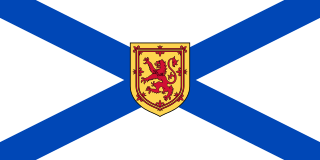 W
WThe flag of Nova Scotia consists of a blue saltire on a white field defaced with the royal arms of Scotland. Adopted in 1929 after a royal warrant was issued, it has been the flag of the province since January 19 of that year. It is a banner of arms modelled after the province's coat of arms. Utilized as a pennant since 1858, it was officially recognized under primary legislation as Nova Scotia's flag in 2013. When flown with the flags of other Canadian provinces and the national flag, it is fourth in the order of precedence.
 W
WThe flag of Nunatsiavut is the flag adopted by the Labrador Inuit Association to represent the Inuit of Labrador and their Land Claims Settlement Area called Nunatsiavut. The flag features the traditional Inuit inuksuk coloured white, blue, and green, echoing the flag of Labrador.
 W
WThe official flag of Nunavut was proclaimed on 1 April 1999, along with the territory of Nunavut in Canada. It features a red inuksuk—a traditional Inuit land marker—and a blue star, which represents the Niqirtsuituq, the North Star, and the leadership of elders in the community. The colours blue and yellow represent the riches of the land, sea and sky. It was adopted following a process where input was sought from local communities and submissions were solicited from the Canadian public.
 W
WThe flag of Ontario is the provincial flag of Ontario, Canada. It is a defaced Red Ensign, with the Royal Union Flag in the canton and the Ontario shield of arms in the fly. The flag of Ontario was derived from the Canadian Red Ensign, which was used as a civil ensign and as a de facto flag of Canada from the late 19th century to 1965. May 21 is Ontario Flag Day.
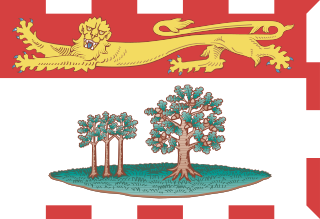 W
WThe flag of Prince Edward Island, Canada, is a banner modelled after the provincial arms. The flag has the proportions 2:3; the three sides away from the mast are bordered by alternating bands of red and white.
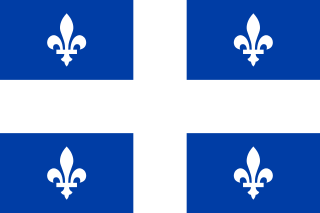 W
WThe flag of Quebec, called the Fleurdelisé represents the Canadian province of Quebec. It consists of a white cross on a blue background, with four white fleurs-de-lis.
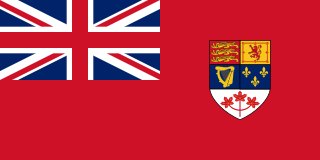 W
WThe Canadian Red Ensign served as a nautical flag and civil ensign for Canada from 1892 to 1965 and later as an unofficial flag of Canada before 1965. The flag is a British red ensign, with the Royal Union Flag in the canton, adorned with the shield of the coat of arms of Canada.
 W
WThe Royal Canadian Air Force Ensign is the official flag which is used to represent the Royal Canadian Air Force. The Ensign has an air force blue field defaced with the Canadian Flag in the canton and the current Royal Canadian Air Force roundel in the fly.
 W
WThe provincial flag of Saskatchewan is blazon per fess vert and or, in the fly a prairie lily slipped and leaved proper, in the dexter chief an escutcheon of the coat of arms of Saskatchewan fimbriated argent. The symbolism within the flag is shown just with the colours; yellow representing the grain fields in the southern portion of the province where as the green represents the northern forested areas. The Western red lily in the fly of the flag is the provincial flower. In 2017, The Minister of Parks, Culture and Sports designated September 22 as Saskatchewan Flag Day.
 W
WThe flag of Windsor, Ontario, was designed by Hector Lacasse, former mayor of adjacent Tecumseh, during a local contest in 1971. The blue and white represent the Detroit River and Saint Lawrence Seaway, respectively. The flag contains the seal of the city in the upper left and a rose in the lower right, highlighting Windsor's alternate motto, "The Rose City"/"City of Roses." The city seal was replaced in 1992 by a corporate seal. The date of 1854 on the seal signifies the final date in which the railroad to Windsor was completely built and the city was formed by the amalgamation of several other settlements. It is also the date that it was founded as a town.
 W
WThe flag of Yukon, is a green, white, and blue tricolour with the coat of arms of Yukon at the centre above a wreath of fireweed, the territorial flower. An official flag for Yukon was created during the 1960s, a decade in which the national flag of Canada was chosen as well as several other provincial flags were created. The flag of Yukon was officially selected from a territory-wide design competition in 1967, with the winning design adopted on March 1, 1968.
 W
W